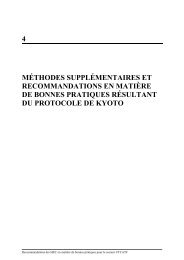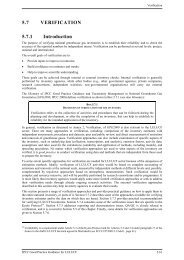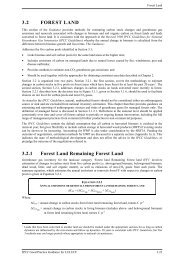Use of Models and Facility-Level Data in Greenhouse Gas Inventories
Use of Models and Facility-Level Data in Greenhouse Gas Inventories
Use of Models and Facility-Level Data in Greenhouse Gas Inventories
You also want an ePaper? Increase the reach of your titles
YUMPU automatically turns print PDFs into web optimized ePapers that Google loves.
<strong>Use</strong> <strong>of</strong> <strong>Models</strong> <strong>and</strong> <strong>Facility</strong>-<strong>Level</strong> <strong>Data</strong> <strong>in</strong> <strong>Greenhouse</strong> <strong>Gas</strong> <strong>Inventories</strong><br />
Dur<strong>in</strong>g the Phase 1 EU ETS, from 2005 to 2007, several economic sectors had many sites that were opted-out <strong>of</strong> EU<br />
ETS due to pre-exist<strong>in</strong>g emissions trad<strong>in</strong>g arrangements with<strong>in</strong> sector-wide Climate Change Agreements (CCAs).<br />
However, from 2008 onwards the CCA opt-outs have ceased <strong>and</strong> hence the number <strong>of</strong> UK <strong>in</strong>stallations operat<strong>in</strong>g with<strong>in</strong><br />
the EUETS has <strong>in</strong>creased. This has allowed a more detailed analysis to be carried out for 2008.<br />
A specific example <strong>of</strong> where the ETS data has helped improved the accuracy <strong>of</strong> the GHG <strong>in</strong>ventory is the report<strong>in</strong>g <strong>of</strong><br />
petroleum coke use.<br />
In DUKES, some petroleum coke is allocated to ref<strong>in</strong>eries, <strong>and</strong> the rema<strong>in</strong>der to non energy use. It is, however, known<br />
that petroleum coke is also used as a fuel <strong>in</strong> the domestic sector, power stations <strong>and</strong> the cement <strong>in</strong>dustry. Analysis <strong>of</strong><br />
the EU ETS data also <strong>in</strong>dicates an under allocation <strong>of</strong> petroleum coke to ref<strong>in</strong>eries. The UK GHG <strong>in</strong>ventory therefore<br />
deviates from both the total petroleum coke use, <strong>and</strong> the sectoral allocation presented <strong>in</strong> DUKES.<br />
5 <strong>Use</strong> <strong>of</strong> EUETS data <strong>in</strong> EU greenhouse <strong>in</strong>ventories<br />
The text <strong>in</strong> the sections below has been summarised from the 2010 National Inventory Report <strong>of</strong> the EU. It provides an<br />
overview <strong>of</strong> the way that ETS data can be used <strong>in</strong> the GHG <strong>in</strong>ventories <strong>of</strong> the EU MSs, a summary <strong>of</strong> the way that ETS<br />
data is currently be<strong>in</strong>g used by MSs, <strong>and</strong> provides detailed examples <strong>of</strong> how the data have been used <strong>in</strong> three Member<br />
States.<br />
5.1.1 Overview<br />
The ETS generates an EU-27 data set on verified <strong>in</strong>stallation-specific CO 2 emissions for the sectors covered by the<br />
scheme. The ETS <strong>in</strong>cludes CO 2 emissions from energy <strong>in</strong>dustries <strong>and</strong> manufactur<strong>in</strong>g <strong>in</strong>dustries, <strong>in</strong> particular<br />
combustion <strong>in</strong>stallations, m<strong>in</strong>eral oil ref<strong>in</strong>eries, coke ovens, production <strong>and</strong> process<strong>in</strong>g <strong>of</strong> ferrous metals, <strong>and</strong> m<strong>in</strong>eral<br />
<strong>in</strong>dustries (cement, glass, lime, bricks <strong>and</strong> tiles, other ceramic materials) if the <strong>in</strong>stallations exceed certa<strong>in</strong> capacity<br />
thresholds. In 2008 the scope <strong>of</strong> the EU ETS has been exp<strong>and</strong>ed to <strong>in</strong>clude petrochemical crack<strong>in</strong>g <strong>in</strong>stallations,<br />
m<strong>in</strong>eral wool production <strong>and</strong> carbon black production. At the moment, the greenhouse gases covered under the EU ETS<br />
are CO 2 (s<strong>in</strong>ce 2005) <strong>and</strong> N 2O (s<strong>in</strong>ce 2010). However, other greenhouse gases <strong>and</strong> activities will be <strong>in</strong>cluded <strong>in</strong> the<br />
scope <strong>of</strong> the EU ETS from 2013 onwards. In July 2006 the Climate Change Committee adopted unanimously the<br />
revised Monitor<strong>in</strong>g <strong>and</strong> Report<strong>in</strong>g Guidel<strong>in</strong>es for the ETS. The new Guidel<strong>in</strong>es entered <strong>in</strong>to force on 1st January 2008.<br />
5.1.2 How might EUETS data be able to improve the EU GHG <strong>in</strong>ventory?<br />
The EU <strong>in</strong>ventory is composed <strong>of</strong> the sum <strong>of</strong> the GHG <strong>in</strong>ventories <strong>of</strong> the Member States <strong>of</strong> the EU. The plant-specific<br />
emissions data reported by operators under the EUETS can be used <strong>in</strong> different ways for the purposes <strong>of</strong> the E GHG<br />
<strong>in</strong>ventories:<br />
1) Reported verified emissions can be directly used <strong>in</strong> the GHG <strong>in</strong>ventory to report CO 2 emissions for a specific<br />
source category. This requires that the coverage <strong>of</strong> the respective ETS emissions is complete for the<br />
respective source category <strong>and</strong> that ETS activities <strong>and</strong> CRF source categories follow the same def<strong>in</strong>itions. If<br />
ETS emissions are not complete, the emissions for the rema<strong>in</strong><strong>in</strong>g part <strong>of</strong> the source category not covered by<br />
the EU ETS have to be calculated separately <strong>and</strong> added to the ETS emissions.<br />
2) Emission factors (or other parameters such as oxidation factors) reported under the EUETS can be compared<br />
with emission factors used <strong>in</strong> the <strong>in</strong>ventory <strong>and</strong> they can be harmonised if the EUETS provides improved<br />
<strong>in</strong>formation.<br />
3) Activity data reported under the EUETS can be used directly for the GHG <strong>in</strong>ventory, <strong>in</strong> particular for source<br />
categories where energy statistics face difficulties <strong>in</strong> disaggregat<strong>in</strong>g fuel consumption to specific subcategories,<br />
e.g. to specific <strong>in</strong>dustrial sectors.<br />
4) <strong>Data</strong> from EUETS can be used for more general verification activities as part <strong>of</strong> national quality assurance (QA)<br />
activities without the direct use <strong>of</strong> emissions, activity data or emission factors.<br />
5) <strong>Data</strong> from EUETS can improve completeness <strong>of</strong> the estimation <strong>of</strong> IPCC source categories when additional data<br />
for source categories become available from EUETS.<br />
6) ETS data can improve the allocation <strong>of</strong> <strong>in</strong>dustrial combustion emissions to sub-categories under 1A2<br />
Manufactur<strong>in</strong>g Industries <strong>and</strong> Construction;<br />
7) The comparison <strong>of</strong> the data sets can be used to improve the uncerta<strong>in</strong>ty estimation for the GHG<br />
<strong>in</strong>ventories based on the ranges <strong>of</strong> data reported by <strong>in</strong>stallations.<br />
IPCC Expert Meet<strong>in</strong>g Report 89 TFI

















